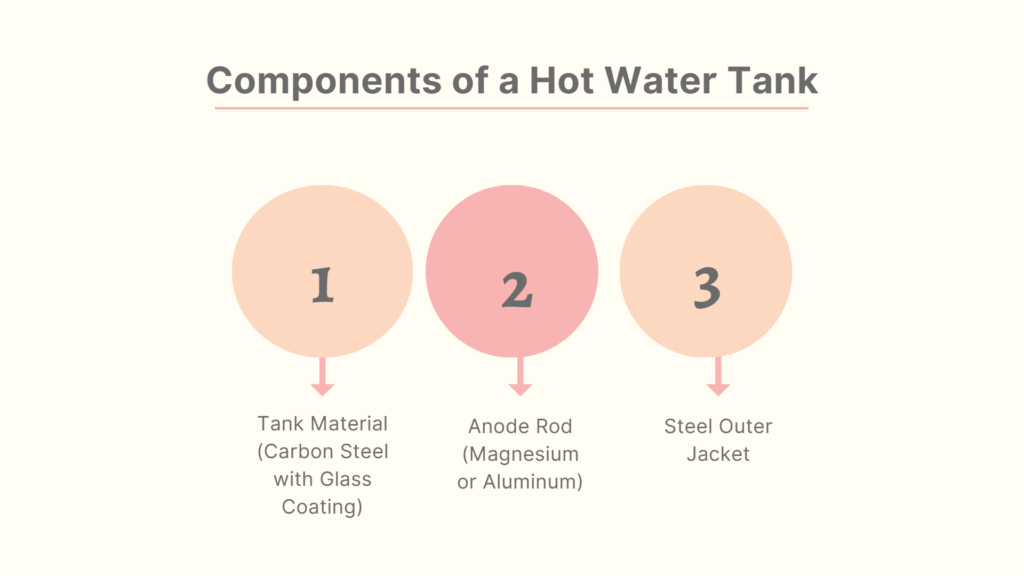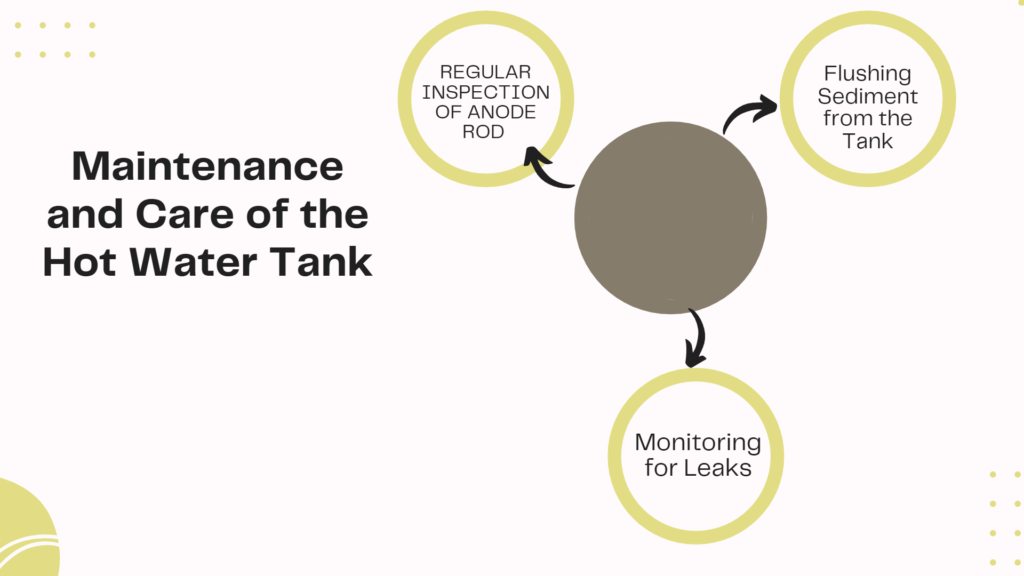Table of Contents

Are you curious to know what goes on inside your hot water tank? It’s a fascinating piece of technology, designed using various metals including carbon steel and aluminum. In this comprehensive guide, we’ll dive into understanding the composition of metal in a hot water tank and how it impacts its functionality.
Stay tuned, as we unravel these metallic mysteries one layer at a time!
Key Takeaways
- The composition of metal in a hot water tank, including carbon steel with glass coating and magnesium or aluminum anode rods, plays a crucial role in protecting against corrosion and ensuring heat transfer efficiency.
- Regular inspection and maintenance of the anode rod are essential to prevent corrosion within the tank and extend its lifespan.
- Flushing sediment from the tank helps maintain efficiency and prolongs the lifespan of the hot water heater.
- Monitoring for leaks is important to identify any issues early on and prevent potential water damage.
Components of a Hot Water Tank

The components of a hot water tank include the tank material, anode rod, and steel outer jacket.
Tank Material (Carbon Steel with Glass Coating)
The hot water tank’s core material plays a pivotal role in its performance and longevity. Primarily, the inner shell of a typical water heater is constructed from high-quality carbon steel, robust and durable enough to withstand heat and pressure over time.
To fortify this, manufacturers often apply a layer of glass coating inside the tank. This specialized coating acts as an extra shield of protection against corrosive elements present in water that can potentially damage the metal over time.
The combination of carbon steel with glass lining thus makes up an efficient defense system within the hot water heater, ensuring it remains functional for several years without succumbing to deterioration or rampant corrosion.
Anode Rod (Magnesium or Aluminum)
An essential component of a hot water tank is the anode rod, which plays a crucial role in protecting the tank against corrosion. Anode rods are typically made of either magnesium or aluminum.
These rods are suspended inside the tank and work by attracting corrosive elements that would otherwise attack the metal lining. By sacrificing themselves through a process called electrolysis, these rods prevent corrosion from reaching the inner surface of the tank.
The choice between magnesium and aluminum anode rods depends on factors such as water quality and the location of your water heater. Generally, magnesium anode rods are more effective in areas with soft water, while aluminum anode rods are better suited for areas with hard water or high mineral content.
It’s important to regularly inspect and replace these anode rods to ensure their continued effectiveness in preventing corrosion within your hot water tank.
Steel Outer Jacket
The steel outer jacket of a hot water tank serves as the protective layer that encloses and supports the inner components. This durable casing not only protects the tank from potential damage but also helps to insulate it, preventing heat loss and improving energy efficiency.
The high-quality steel used in the outer jacket ensures strength and durability, allowing the hot water tank to withstand pressure and maintain its structural integrity over time. Its sturdy construction provides an added layer of security against leaks or other potential issues, ensuring that your hot water tank functions optimally for years to come.
How the Composition of Metal Affects the Water Heater
The composition of metal in a hot water tank plays a crucial role in its performance, impacting both protection against corrosion and heat transfer efficiency.
Protection Against Corrosion
The metal composition of a hot water tank plays a crucial role in protecting it against corrosion. The inner tank is typically made of high-quality steel, which is specifically chosen for its ability to resist rust and corrosion caused by constant exposure to water.
Additionally, the tank is lined with porcelain enamel or glass material to provide an extra layer of protection. To further combat corrosion, magnesium or aluminum rods are suspended within the tank.
These sacrificial anode rods attract corrosive elements in the water, sacrificing themselves instead of the tank’s metal surfaces. Regular inspection and maintenance of these anode rods are important to ensure optimal corrosion protection for your hot water tank.
Heat Transfer Efficiency
One important aspect to consider when understanding the composition of metal in a hot water tank is its impact on heat transfer efficiency. The material used in the tank plays a crucial role in how effectively heat is transferred to the water inside.
High-quality steel, typically used for the inner tank of a water heater, is known for its excellent thermal conductivity. This means that it efficiently transfers heat from the heating element to quickly warm up your water.
The choice of metal also affects insulation properties. A well-insulated tank helps retain heat and prevent energy loss, resulting in more efficient operation and cost savings over time. Additionally, the tank lining, often made of porcelain enamel or glass material, acts as an additional layer of protection against corrosion and enhances overall heat transfer efficiency.
Maintenance and Care of the Hot Water Tank

Regular maintenance of the hot water tank includes inspecting the anode rod, flushing sediment from the tank, and monitoring for leaks.
Regular Inspection of Anode Rod
Regular inspection of the anode rod is crucial to maintain the longevity and efficiency of your hot water tank. Here’s a step-by-step guide on how to inspect the anode rod:
- Turn off the power supply: Before inspecting the anode rod, make sure to turn off the power supply to the water heater. This ensures your safety during the inspection process.
- Locate the anode rod: The anode rod is usually located at the top of the water heater and can be accessed by unscrewing a hex head cap or removing a plastic cover.
- Check for signs of corrosion: Carefully examine the surface of the anode rod for any signs of corrosion. If you notice heavy corrosion or if more than 50% of the rod is corroded, it needs to be replaced.
- Measure rod thickness: Using a ruler or tape measure, measure the thickness of any remaining metal on the anode rod. Ideally, there should be at least 1/2 inch (12 mm) of metal left on the rod. If it’s less than that, it indicates that the anode rod is nearing its end and should be replaced soon.
- Check for calcium build-up: Calcium deposits can form on the surface of the anode rod over time. These deposits reduce its effectiveness in protecting against corrosion. If you notice significant calcium build-up, consider replacing the anode rod.
- Reinstall or replace: Once you have inspected the condition of the anode rod, either reinstall it if it’s still in good shape or replace it if necessary. Remember to use a new anode rod with similar specifications as your old one.
Flushing Sediment from the Tank
Flushing sediment from the tank of your hot water heater is an important maintenance task that helps maintain its efficiency and prolong its lifespan. Sediment buildup can cause various problems, such as reduced heat transfer and increased energy consumption. Here are the steps to flush sediment from your water heater:
- Turn off the power or gas supply to the water heater.
- Locate the drain valve at the bottom of the tank. It is usually a brass or plastic valve.
- Attach a garden hose to the drain valve, ensuring that it is tightly secured.
- Place the other end of the hose in a nearby floor drain or outside where water can safely drain.
- Open one or more hot water faucets in your home to allow air into the system and facilitate draining.
- Slowly open the drain valve by turning it counterclockwise with a wrench or pliers.
- Allow the tank to drain completely. Depending on sediment buildup, this may take several minutes.
- Once all water has drained, close the drain valve by turning it clockwise.
- Remove and clean any sediment caught in the filter located at the bottom of some tanks.
Monitoring for Leaks
Leakage in a hot water tank can lead to water damage and potential safety hazards. Regular monitoring for leaks is crucial to ensure the optimal performance and longevity of your hot water tank. Here are some important steps to follow:
- Visually inspect the area around the tank for any signs of dampness or water accumulation.
- Check for water stains or discoloration on the floor or walls near the tank.
- Look for puddles or moisture around fittings, valves, and connections.
- Examine the pressure relief valve and drain valve for any leakage.
- Listen for hissing sounds, which could indicate a hidden leak.
- Monitor your water bill for any unexplained increases, as it could be a sign of a concealed leak.
Conclusion
In conclusion, understanding the composition of metal in a hot water tank is crucial for ensuring its longevity and optimal performance. The choice of materials, such as carbon steel with glass coating and magnesium or aluminum anode rods, directly affects corrosion protection and heat transfer efficiency.
Regular maintenance and care, including inspecting the anode rod and flushing sediment from the tank, are essential for prolonging the lifespan of your water heater. By familiarizing yourself with these key components and their functions, you can make informed decisions about repair or replacement when necessary.
FAQs
1. What types of metal are commonly used in hot water tanks?
Hot water tanks are typically made from steel, stainless steel, or glass-lined steel. Steel tanks are the most common and affordable option, while stainless steel tanks offer increased durability and resistance to corrosion. Glass-lined steel tanks combine the best qualities of both materials.
2. How does the composition of metal in a hot water tank affect its performance?
The composition of metal in a hot water tank can impact its performance in terms of durability, corrosion resistance, heat retention, and energy efficiency. Different metals have varying properties that determine their ability to withstand high temperatures and resist rust or other forms of deterioration.
3. What is galvanic corrosion and how does it relate to the composition of metal in a hot water tank?
Galvanic corrosion occurs when two different metals come into contact with each other in the presence of an electrolyte (such as water), resulting in accelerated corrosion of one or both metals. The choice of metals used in a hot water tank must consider their compatibility to prevent galvanic corrosion and ensure long-term functionality.
4. Can I replace a damaged metal component in my hot water tank?
In some cases, it is possible to replace damaged metal components within a hot water tank without needing to replace the entire unit. However, this is dependent on various factors such as the availability of replacement parts for your specific model and whether any warranties or service agreements cover such repairs. It’s recommended to consult with a professional plumber or manufacturer for guidance on repairing or replacing specific components based on your situation.
